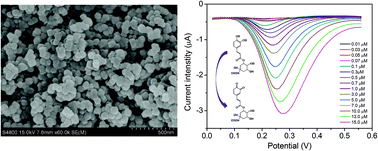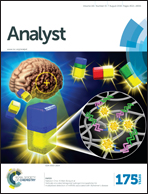Highly stable and ultrasensitive chlorogenic acid sensor based on metal–organic frameworks/titanium dioxide nanocomposites
Abstract
Metal–organic frameworks/titanium dioxide (UiO-66-NH2/TiO2) nanocomposites have been prepared by a simple hydrothermal reaction and they exhibit excellent electrocatalytic activity for chlorogenic acid oxidation due to the synergic effect of UiO-66-NH2 and TiO2. Under the optimal conditions, the sensor can be employed in the quantification of chlorogenic acid in the ranges of 0.01–1.0 μmol L−1 and 1.0–15 μmol L−1 with an ultralow detection limit of 7 nmol L−1 (S/N = 3). Moreover, UiO-66-NH2/TiO2 nanocomposites demonstrate significant stability in acidic buffer solution and maintain their electrocatalytic activities at least up to 90 cycles. The potential utility was validated by the analysis of coffee and tea samples and good recoveries were obtained from different spiked values. The UiO-66-NH2/TiO2 based sensor with highly sensitive, selective and stable consecutive monitoring of chlorogenic acid is a promising candidate for the construction of highly active electrocatalyst in electrochemical biosensors.


 Please wait while we load your content...
Please wait while we load your content...